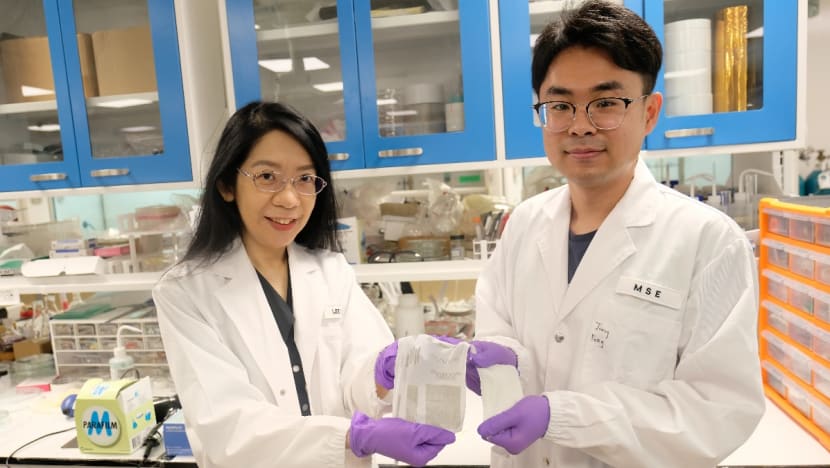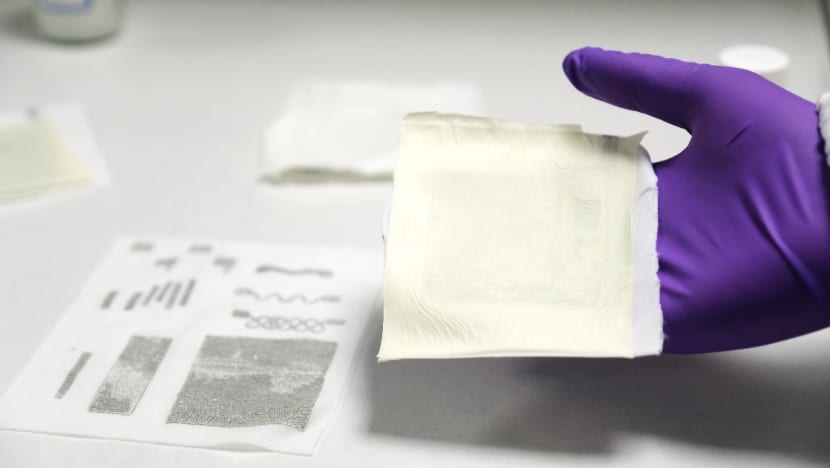NTU scientists develop 'fabric' that turns body movement into electricity

Professor Lee Pooi See (left) and PhD student Jiang Feng. (Photo: NTU Singapore)
SINGAPORE: Scientists from the Nanyang Technological University (NTU) have developed a "fabric" that turns body movement into electricity.
This fabric could one day be integrated into clothes or wearable electronics to power devices on the go, the university said in a news release on Thursday (Jun 2).
The fabric is stretchable, waterproof and strong as it is made with a spandex base layer and integrated with a "rubber-like material".
Washing, folding and crumpling also did not cause any performance degradation, said NTU, adding that it could maintain stable electrical output for up to five months.
A crucial component in the fabric is a polymer that, when pressed or squeezed, converts mechanical stress into electrical energy.
In a proof-of-concept experiment reported in the scientific journal Advanced Materials in April, the NTU team demonstrated that tapping on a 3cm by 4cm piece of the new fabric generated enough electrical energy to light up 100 LEDs or charge various devices that store electrical energy and are found in equipment like mobile phones.
Materials scientist and NTU Associate Provost Professor Lee Pooi See said there have been many attempts to develop fabric or garments that can harvest energy from movement.
However, a big challenge has been to develop something that does not degrade in function after being washed, and at the same time retains excellent electrical output.
"In our study, we demonstrated that our prototype continues to function well after washing and crumpling. We think it could be woven into T-shirts or integrated into soles of shoes to collect energy from the body’s smallest movements, piping electricity to mobile devices," said Prof Lee, who also led the study.

HOW DOES IT WORK?
NTU said the fabric is an energy harvesting device that turns vibrations produced from the smallest body movements into electricity.
The prototype produces electricity in two ways: When it is pressed or squashed (piezoelectricity), and when it comes into contact or is in friction with other materials, such as skin or rubber gloves (triboelectric effect).
To fabricate the prototype, the researchers first made a stretchable electrode by screen-printing an "ink" comprising silver and styrene-ethylene-butylene-styrene (SEBS), which is a rubber-like material found in teethers and handlebar grips.
This stretchable electrode is then attached to a piece of nanofibre fabric that is made up of two main components: A polymer that produces an electrical charge when compressed, bent, or stretched, as well as lead-free perovskites, which is a "promising material" in the field of solar cells and LEDs.
NTU researchers found that their fabric could harness energy from a range of human movements by attaching it to the arm, leg, hand, and elbow, as well as to the insoles of shoes. This also did not impact movement.
"Despite improved battery capacity and reduced power demand, power sources for wearable devices still require frequent battery replacements. Our results show that our energy harvesting prototype fabric can harness vibration energy from a human to potentially extend the lifetime of a battery or even to build self-powered systems.
"To our knowledge, this is the first hybrid perovskite-based energy device that is stable, stretchable, breathable, waterproof, and at the same time capable of delivering outstanding electrical output performance," said Prof Lee.
The team is now looking at how the same fabric could be adapted to harvest different forms of energy.

No comments
Share your thoughts! Tell us your name and class for a gift (: